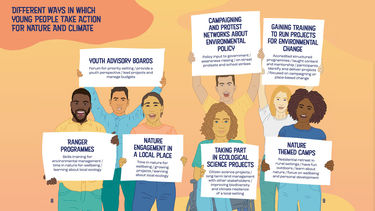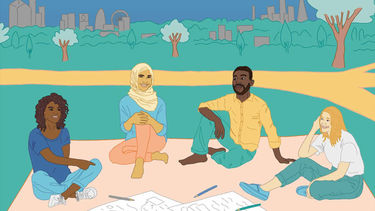More young people are involved in actions and activism for nature recovery and climate resilience than ever before. Our research found a wide range of ways in which they provide brilliant inspiration for all of us. It’s worth listening to young people to learn how to take action in ways that are collaborative and inclusive and guard against eco-anxiety. We have published this resource for ideas and inspiration, and you can order free print copies from here.
We know that activism can be hard both to start up and sustain for all groups. Teenagers and young adults are often dealing with many life pressures and have limited access to decision makers which can mean it’s even harder. Our research looked at a wide range of projects which were either set up by young people or initiated to support young people taking action on nature or climate projects. We asked the project members and leaders about what was important to them, what worked well and what was a problem?
We were keen to find out how these projects were actively working to include people who are underrepresented or need extra support to be involved, especially given the lack of diversity in the environmental sector. What does equality and better representation look like in practice, and how do you avoid tokenism?
Care-full Collective Action
We found many examples of imaginative and thoughtful actions and approaches within these groups. Young people were often very caring towards each other and favoured supportive and collaborative ways of working to reduce stress and eco-anxiety. They were understanding of their fellow group-members when they were struggling with pressures around school, work or the practicalities of getting involved. A mixture of online and offline meetings often seemed to work well and making sure that they found time to relax and socialise, especially in nature.
The group is quite supportive when it comes to burnout. If someone says I'm not coming to the meeting this weekend, too tired, no one turns around and says, ‘you need to come’, or ‘we are dependent on you’.
Member, Climate protest group
Connecting Local and Global
Solidarity is important for many young people, and making links between global and local issues is meaningful and intuitive for many groups… as well as being good science! Storytelling is often used as a powerful means of understanding the connections between places and between social and environmental justice. A UK based youth campaign group at COP26 used their session to link up with young people in the Philippines and highlight their voice and experiences of climate change impacts.
This work inspired me to learn about these new things. It was relatable to me because work in the garden reminded me of my childhood, my home. My grandparents live in Poland. They farm, on their balcony and land to grow crops. I usually go to Poland every summer for a month and spend time with my grandparents and family.
Member, Community garden project
Many young people also have connections through their own families or communities, and have a lot of knowledge to share that is relevant to understanding nature and climate change.
Doing better
It’s important for the whole environmental sector, climate activism and nature advocacy, to find ways to support young people in raising their voice and making a difference.
“Adults want young people to participate and do more but also do not provide us with the opportunity. There needs to be more conversation between young people and decision makers. We need to be a more integral part of the board meetings”.
Member, Youth advisory board
Three ideas to consider:
- Use youth-work strategies and expertise to meet young people where they are at (physically and mentally).
- Resource young people. Financial support is always great, but access to networks, help with logistics, and skills development are also deeply valued, and demonstrate commitment beyond tokenism.
- Share responsibility for young people’s mental health in this work and embed this in all projects. Whether through local park picnics or rural residentials, providing safe and fun times in nature can help individuals and the group.
To achieve diversity of representation without tokensim requires careful listening and meaningful collaborations.
Three ideas to consider:
- Do the leg-work. Environmental organisations wanting to collaborate with young people need to be prepared to be present within young people’s spaces (physical and digital) and take on their modes of working.
- Address practicalities. These are a vital and often limiting factor for young people. Work slowly and collaboratively to ensure everybody feels welcome and able to participate. This may mean physical access on site, times of meeting, financial or travel support, training for staff members or creating safe spaces with a focus on a specific group (for example, defined by gender, race or class).
- Always connect local and global, social and environmental justice. This is important for ensuring actions are relevant to young people’s life experiences and gives space for their own stories to belong.
A big thank you to the participating organisations and the young people involved for the generosity of your time, ideas and reflections. A full list of these is given in the resource.
Notes on the Research
1. The projects highlighted in this resource mostly take place outside of school contexts. The term ‘young people’ is used to include teenagers and young adults, from 12 to 25 years of age.
2. We interviewed leaders and facilitators from 24 organisations from across the UK. Our interviews covered the history of these groups and projects, format and approaches they use to involve and support young people, successes and challenges. We then observed sessions and interviewed young people for four of these. We focused on young people’s experience of being part of these projects, what they enjoy, how they work through ongoing challenges, their motivation for taking part and what encourages them.
3. The research was conducted by the Department of Landscape Architecture, University of Sheffield. It is one part of a longer project called ‘Voices of the Future’ which explores new methods of engaging young people in designing, creating and caring for treescapes, including natural woodlands and urban parks, and is led by Prof. Kate Pahl at Manchester Metropolitan University. This work was supported by the Natural Environment Research Council [NE/V021370/1].



